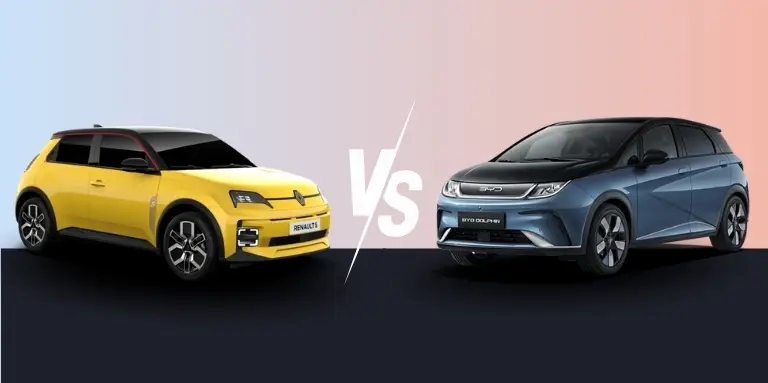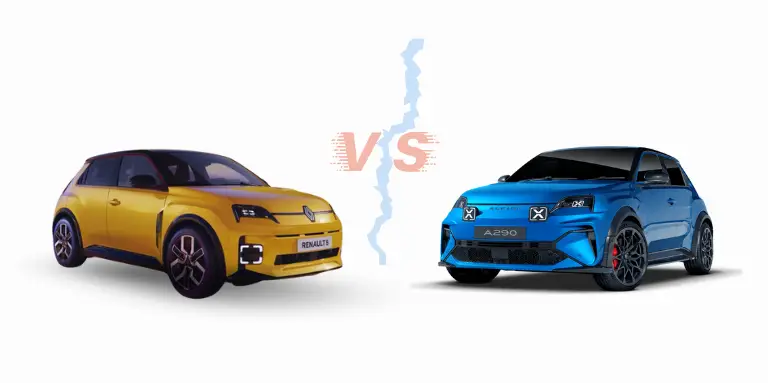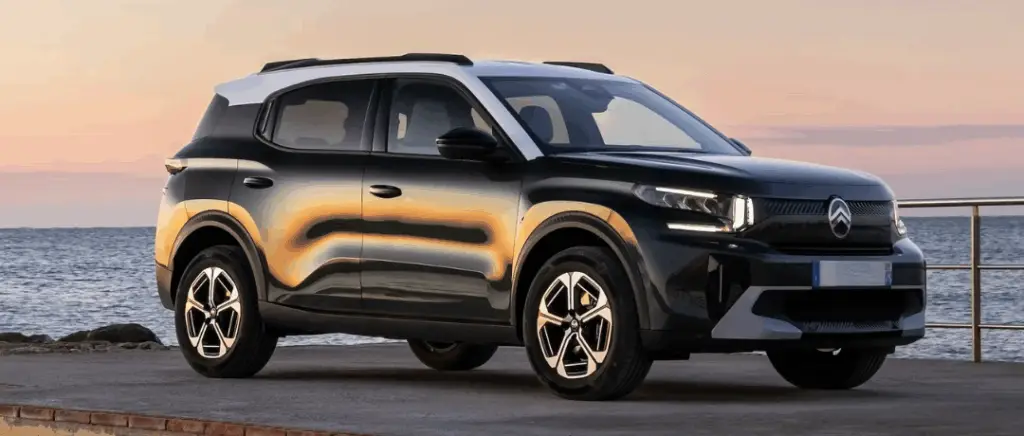Performance and engines: which electric city car, BYD Dolphin or Renault 5, is more dynamic?
La BYD Dolphin is based on the modular e-Platform 3.0specifically designed to optimise the efficiency and performance of electric vehicles. Thanks to this architecture, the Dolphin can deliver a powerful 204 bhp (150 kW) and 310 Nm of torque, enabling it to accelerate from 0 to 100 km/h in just 7 seconds. This configuration makes the Dolphin one of the most dynamic electric city cars in its category, offering crisp acceleration and responsive driving in town and on the open road.
Opposite her, the Renault 5 electric is based on the new AmpR Small platform (formerly CMF-B EV), developed by Renault for its urban electric models. It offers two power levels: 120 bhp (90 kW) and 150 bhp (110 kW), with maximum torque of 245 Nm for the most powerful version. The 0 to 100 km/h time is 8 to 9 seconds, depending on the version, which is still competitive for the segment, but slightly behind the Dolphin.
Autonomy and recharging time: which wins out between the Renault 5 and the BYD Dolphin?
In terms of range, the two models perform very similarly on paper. The BYD Dolphin is equipped with a battery of 60 kWh, offering a WLTP range of 427 km, while the Renault 5 electricwith its 52 kWh net battery, claims 410 km according to the WLTP standard. In real-world conditions, the combined range recorded is around 356 km for the Dolphin and 359 km for the Renault 5, making them almost equal. In terms of fuel consumption, the Renault 5 is more efficient, with an average of 14.5 kWh/100 km, compared with 17 kWh/100 km for the Dolphin.
For recharging, the BYD Dolphin accepts up to 11 kW in alternating current (AC) and 88 kW in direct current (DC), allowing 30 to 80 % of battery to be recovered in around 29 minutes on a fast terminal. The Renault 5 also offers 11 kW AC charging and, depending on the version, comparable DC power (generally between 80 and 100 kW in this segment), which ensures competitive charging times. In short, the Dolphin offers a slightly longer range on paper, but the Renault 5 makes up for this with better energy efficiency and similar recharging times, making for a very close comparison between the two electric city cars.
Style, comfort and roominess: BYD Dolphin or Renault 5, which city car should you choose for everyday use?
Exterior styling and quality of finish: can the BYD Dolphin rival the Renault 5?
La BYD Dolphin adopts a modern, sharp style, with a silhouette that is slightly longer (3.99 m) and taller than the Renault 5, but also slightly narrower. Its design contrasts with that of the Renault 5, which relies on nostalgia and retro charm to seduce, taking up the aesthetic codes of the original R5 while modernising them. In terms of exterior equipment, the Dolphin is generous from the intermediate trim levels upwards, incorporating LED headlights, 16-inch alloy wheels, tinted windows and electric folding mirrors as standard.
Inside, the BYD Dolphin surprises with its level of equipment and the perceived quality of its assembly, even if the materials are still predominantly hard. The ambience is resolutely contemporary, with digital instrumentation and a central adjustable screen. The Renault 5, for its part, pays particular attention to its finish and on-board ambience, focusing on high-value materials and a colourful presentation in keeping with its neo-retro spirit. Ergonomics and build quality are high on the agenda, with particular attention paid to detail. While the Dolphin impresses with its technology and practicality, the Renault 5 retains the upper hand in terms of refinement and stylistic consistency, appealing to fans of iconic design.
Interior space, boot space and comfort: which of the two city cars is the most functional?
La BYD DolphinThanks to its more generous dimensions (length 4.29 m, width 1.77 m, height 1.57 m), it offers a spacious interior for five passengers and a high level of comfort. Its boot volume of 345 litres puts it ahead of the Renault 5, which offers 326 litres, a decent figure for a city car, but slightly less. The Dolphin's rear space is also superior, benefiting from a longer wheelbase and a flat floor, which makes it easier to accommodate passengers.
La Renault 5The Dolphin, which is more compact (3.92 m long), is perfectly suited to urban use and is agile in town. Its interior space is well optimised, but the rear passenger compartment and boot volume are a little smaller than those of the Dolphin. In terms of comfort, the R5 boasts a well-kept appearance, wraparound seats and good soundproofing, while the Dolphin favours modularity and practicality, with plenty of storage space and a raised driving position.
See also our article :
Technological equipment: BYD Dolphin vs Renault 5, which model offers the most advanced innovations?
User interface and multimedia systems: which city car is the most intuitive and connected?
La BYD Dolphin offers a modern multimedia system, centred on a rotating 10.1-inch touchscreen, which is available on all models. The system stands out for its responsiveness, the quality of its graphics and advanced functions such as voice control, access to YouTube and even video games. Apple CarPlay and Android Auto integration is possible, but only in horizontal mode, which somewhat limits the versatility of the rotating screen. Access to the electric car is facilitated by a hands-free key and even NFC access via smartphone. The whole package offers a complete connected experience, although some aspects are more of a gadget than a real added value to everyday life.
La Renault 5 electricFor its part, the R5 features a modern, intuitive user interface, with a multimedia system designed for ease of use and ergonomics. Although the precise details of the screen and connected functions vary from version to version, the R5 is designed to meet contemporary expectations, with clear controls, full connectivity and seamless smartphone integration. The emphasis is on accessibility and ease of use, which will appeal to users looking for an uncomplicated experience.
Broadly speaking, the BYD Dolphin wins out on the basis of its wealth of functions and the originality of its interface, while the Renault 5 focuses on simplicity, intuitiveness and ergonomics, two approaches that will appeal to different user profiles.
Driving aids and active safety: Renault 5 or BYD Dolphin, which offers the best level of protection?
The BYD Dolphin is distinguished by its comprehensive safety equipment, starting with the base versions, which include a host of driving assistance features as standard: autonomous emergency braking, lane keeping, adaptive cruise control, reversing camera and parking radars. Top-of-the-range versions add features such as blind spot monitoring and hands-free access. The quality of manufacture and robustness of the assemblies also contribute to a greater sense of safety on board.
The Renault 5 electric, though more compact, is no slouch when it comes to active safety. It also offers an arsenal of state-of-the-art driving aids, including automatic emergency braking, lane departure warning, road sign recognition and, depending on the version, adaptive cruise control and perimeter surveillance systems. The emphasis is on urban safety and accident prevention, with technologies tailored to everyday needs.
The two city cars therefore offer a high level of protection, with the BYD Dolphin standing out for the generosity of its equipment right from the start of the range, while the Renault 5 relies on the modernity and effectiveness of its driving aids, perfectly calibrated for city driving and versatility.
Value for money and budget: BYD Dolphin or Renault 5, which electric city car is the best value?
Equipment levels, options and warranties: is the BYD Dolphin more generous than the Renault 5?
The BYD Dolphin stands out for its very generous equipment right from the start of the range. It comes as standard with equipment that is often reserved for the higher trim levels of its rivals, such as adaptive cruise control, lane-keeping assist, reversing camera, hands-free key, rotary touchscreen and LED headlights. This generosity puts the Dolphin ahead of the pack in terms of equipment/price ratio, especially when compared with the Renault 5, which reserves certain driving aids and technological options for the highest versions or as optional extras. When it comes to warranties, BYD generally offers a competitive manufacturer's warranty, often in line with or above the European market average, which reassures buyers of long-term reliability.
The Renault 5, for its part, offers a comprehensive range of standard equipment on the higher versions, but remains more traditional on the entry-level. It relies on a neat presentation, good ergonomics and customisation options, but some advanced equipment (driving aids, connected technologies) requires going upmarket or dipping into the options catalogue. In short, the BYD Dolphin is more generous and competitive in terms of equipment from the first trim levels upwards.
Purchase price and running costs: which city car is the most economical over the long term?
In terms of purchase price, the Renault 5 is the most affordable, with a base price of around €28,100, compared with €33,300 for the BYD Dolphin, depending on the version compared. This difference of almost €5,000 can make a big difference to the decision to buy, especially if you're on a tight budget.
In terms of running costs, fuel consumption plays a key role: the Renault 5 consumes an average of 14.8 kWh/100 km, lower than the 15.9 kWh/100 km of the BYD Dolphin. This translates into savings on running costs, particularly for heavy drivers or those who use their vehicle mainly in town.
In terms of reliability and maintenance costs, both models benefit from the advantages of electric motoring (reduced maintenance, zero CO2 emissions). However, the Renault 5, with its lower fuel consumption and lower purchase price, stands out as the most economical city car in the long term, while the BYD Dolphin makes up for this with more equipment and a slightly longer range.
See also our article :
Conclusion: BYD Dolphin vs Renault 5 comparison chart at a glance
| Criteria | BYD Dolphin | Renault 5 electric |
|---|---|---|
| Purchase price | Approximately €33,300 | From €28,100 |
| Engine power | 204 bhp (150 kW) | 120 to 150 bhp (90 to 110 kW) |
| Couple | 310 Nm | 225 to 245 Nm |
| 0-100 km/h | 7 seconds | 8 to 9 seconds |
| Maximum speed | 160 km/h | 150 km/h |
| Battery capacity | 60 kWh (LFP) | 40 to 52 kWh net |
| WLTP range | 427 km | 307 to 405 km depending on version |
| Average consumption | 15.9 kWh/100 km | 14.8 kWh/100 km |
| Boot volume | 345 litres | 326 litres |
| Dimensions (L x W x H) | 4290 x 1770 x 1570 mm | 3922 x 1744 x 1498 mm |
| Number of places | 5 | 2 to 5 depending on version |
| Key equipment | Rotating touchscreen, adaptive cruise control, lane-keeping assist, reversing camera, LED headlights | Intuitive interface, modern driving aids, customisation options |
| AC/DC recharging | 11 kW AC / 88 kW DC | Approx. 11 kW AC / 80-100 kW DC |
| Tare weight | 1658 kg | 1447 to 1524 kg |
| Manufacturer's warranty | Competitive warranty (European standard) | Renault standard warranty |
For individuals and businesses


































